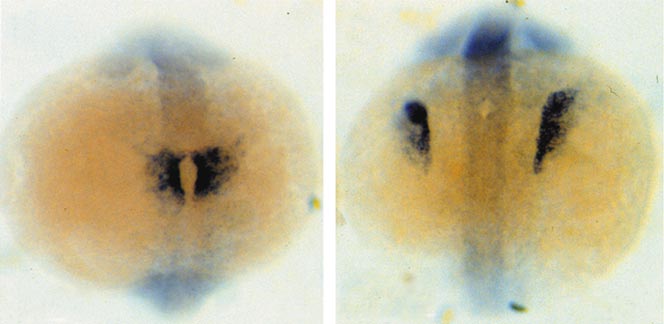Two Hearts Beat as One
By Rebecca Sloan Slotnick
A shattered heart is united during embryonic development
A shattered heart is united during embryonic development

DOI: 10.1511/2000.35.0
In the first precious moments of life, it seems, we all suffer from a broken heart. At least until the molecule sphingosine 1-phosphate arrives to patch things up. Scientists at the University of California at San Francisco have cloned a receptor for the molecule (known as S1P), which they believe is essential for the successful meeting of heart buds during embryonic development.
Early on in the development of the vertebrate heart, a pair of primordial buds settles at opposite ends of the animal. As the embryo continues to develop, these buds migrate, this time towards the midline of the embryo, where they fuse and begin to beat as a single heart. Sometimes, though, the buds fail to move—and it is this occurrence which most interests Didier Stainier and his colleagues.

Working with zebrafish, Stainier's team began cataloging the many mutations affecting heart development. The transparency of the zebrafish embryo allows scientists to easily observe heart bud migration and fusion, making it an ideal model for study. Of particular interest to Stainier's team was the discovery of a mutation that prevents the heart halves from coupling at the midline. The mutation was named miles apart—by a post-doctoral student thinking longingly of a lover overseas. In embryos with the miles apart mutation, each bud forms its own heart, a condition known as cardia bifida, and the embryo generally succumbs before long for lack of adequate circulation. In humans, homozygosity for the mutation results in spontaneous abortion of the embryo at about three weeks.
After isolating the miles apart gene, the team discovered that it codes for a sphyngolipid receptor, that of S1P. Already considered an important molecule in cell growth, survival and improved cell-to-cell adhesion, S1P may be the first lipid molecule found to regulate cell migration in the vertebrate embryo—a role traditionally reserved for proteins and peptides. The discovery of a lipid receptor came as quite a surprise, says Stainier, who vows to continue unraveling the mysteries of the heart.—Rebecca Sloan Slotnick
Click "American Scientist" to access home page
American Scientist Comments and Discussion
To discuss our articles or comment on them, please share them and tag American Scientist on social media platforms. Here are links to our profiles on Twitter, Facebook, and LinkedIn.
If we re-share your post, we will moderate comments/discussion following our comments policy.